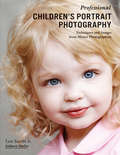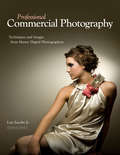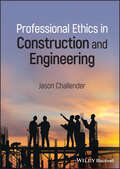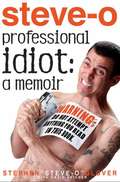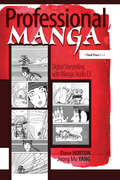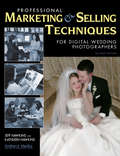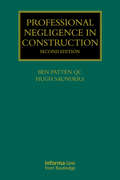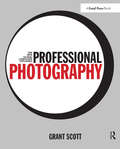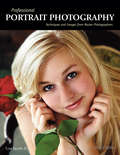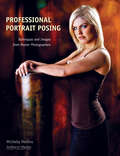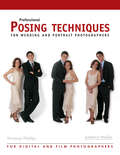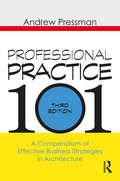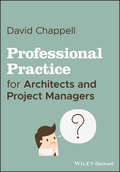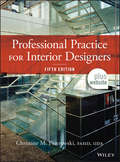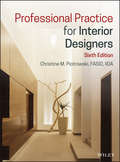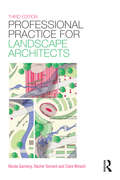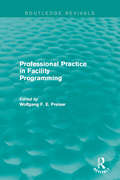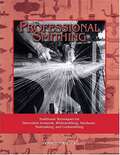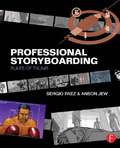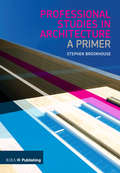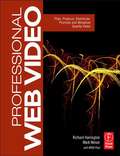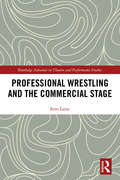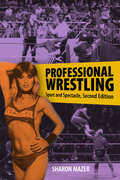- Table View
- List View
Professional Children's Portrait Photography: Techniques and Images from Master Photographers
by Lou Jacobs Jr.Blending advice with example images, this guidebook marshals the wisdom and experience of 15 seasoned professionals to present a comprehensive resource on one of the most challenging subfields in the portrait-photography genre. Chapters feature the varied approaches and practices of each photographer while covering topics such as helping children warm up to the camera, choosing clothes for subjects to wear, and how to deal with kids who simply will not cooperate. Each professional also discusses the business techniques that have helped make his or her studio successful#151;including tips for pricing, hiring assistants, and effective marketing strategies to reach a target audience.
Professional Commercial Photography: Techniques and Images from Master Digital Photographers
by Lou Jacobs Jr.Presenting ideas and commentary as well as photographs, this collection offers new photographers revelations and wisdom from professionals and informs them how to achieve commercial success. Commercial photographers create images that are designed to sell products, services, political candidates, organizations, corporations, and any other marketable commodity or idea, and their clients range from advertising agencies, manufacturers, retail stores, hotels, restaurants, and other businesses. With a section focusing on each of these types of services, this reference provides a quick workshop on an area of expertise, furnishing those new to the business with a wide variety of information about each specialty. Tips for selecting the most effective equipment for each subgenre as well as technical information about each camera combine with business-savvy know-how#151;from marketing, bidding, budgeting, building referrals, managing the office, and more#151;making this a comprehensive reference for being both behind and in front of the lens.
Professional Ethics in Construction and Engineering
by Jason ChallenderProfessional Ethics in Construction and Engineering A comprehensive and incisive how-to guide that walks readers through the implementation of robust ethical standards in everyday construction management and decision-making Recent and high-profile incidents—including the 2017 Grenfell Tower tragedy and the Lakanal House fire in 2009—have been attributed to failures in the building construction, design, and certification industries. Some commentators have suggested that, while professional construction organizations are bound by codes of ethics, such codes may be downplayed or sometimes even ignored in the day-to-day activities of construction professionals. Professional Ethics in Construction and Engineering is a practical and industry-aligned guide on ethical practice in construction management. The book addresses how existing ethical standards should be applied in daily practice and offers case studies and examples to illustrate their effective implementation. The author also provides a toolkit that can be employed by frontline managers facing common ethical dilemmas. Readers will find: Thorough discussions of how problematic and dangerous ethical situations arise and how they should be addressed In-depth explorations of conflicts between legal and moral expectations, as well as mismatches between clients’ business goals and the duties of contracting organizations Playbooks for how impactful decisions should be made and how to uphold ethical standards and values Comprehensive review of existing ethical standards and the legal requirements binding construction professionals found in organizations like RICS, RIBA, and the CIOB A must-read document for construction management practitioners, Professional Ethics in Construction and Engineering will also be invaluable to construction clients, contractors, surveyors, and architects, as well as students of construction-related disciplines at undergraduate and postgraduate level.
Professional Idiot: A Memoir
by Stephen Glover David Peisner"It's mind-blowing to me how utterly far gone Steve-O was, and how he looks back on it in this book with such intelligence, humor, and searing honesty. What a truly unbelievable life."--Johnny KnoxvilleFrom his early days videotaping crazy skateboard stunts to starring in the Jackass movies, there was little that Stephen "Steve-O" Glover wouldn't do. Whether it was stapling his nutsack to his leg or diving into a pool full of elephant crap, almost nothing was out of bounds. As the stunts got crazier, his life kept pace. He developed a crippling addiction to drugs and alcohol, and an obsession with his own celebrity that proved nearly as dangerous. Only an intervention and a visit to a psychiatric ward saved his life. Today he has been clean and sober for more than three years.Professional Idiot recounts the lunacy, the debauchery, the stunts, the drug addiction, and the path to recovery with bravado, humor, and heart."A great book to read before you get on the roller coaster to hell, if you plan on surviving to tell about it like Steve-O did."--Nikki Sixx, author of The Heroin Diaries"This is the perfect book for people who hate reading."--Tommy Lee, author of TommylandThe feedback I've gotten on Facebook and Twitter from those of you who've read this book has been fascinating, heartwarming, and hilarious. I'm happy to keep answering your questions on there, and I encourage more of you to join in the discussion. Hope to hear from you soon, and thank you all so much.Love,Steve-O
Professional Manga: Digital Storytelling with Manga Studio EX
by Steve Horton Jeong Mo YangCombine high-end manga storytelling theory and advice with the tools for digital creation in Manga Studio, guided by expert professional manga-ka. You'll discover manga storytelling techniques, from speed lines to technology, from toning to big sound effects. Steve Horton and Jeong Mo Yang then show you how best to accomplish these techniques using the leading manga art creation program, Manga Studio EX. Every ounce of theory is backed up with step-by-step manga illustrations and Manga Studio screenshots that show how these illustrations were created. See the techniques in action in The Other Side of the Tracks, a new manga short story in the book centerfold which demonstrates at least one example from every technique described. You can also follow the continuing story as a webmanga available at comicspace.com.And there's more! The companion CD includes trial version of Manga Studio EX along with high-resolution image files from the book. Smith Micro has also included a coupon for $100 off the full version of Manga Studio EX.
Professional Marketing & Selling Techniques for Digital Wedding Photographers
by Jeff Hawkins Kathleen HawkinsUpdated to include the latest digital camera models, imaging software, and current image proofing and sales techniques, this business guide teaches wedding photographers how to build a profitable business. From formulating a business plan to presenting final images to clients, the strategies presented help photographers avoid the pitfalls that ruin many wedding photography studios. Photographers learn how to define a target demographic#151;whether that be low-volume big-budget or high-volume low-budget clients#151;and market to those demographics in print, on the Internet, through networking, and at bridal shows. Customer service tips include how to interview clients to ensure a stress-free and enjoyable portrait experience, conduct presession consultations, and write a contract, as well as presentation techniques for wall-size images, coffee-table#150;style books, and guestbooks. The featured images and drawings include a gallery of the author's wedding photographs and samples of advertising, marketing, and promotional literature.
Professional Negligence in Construction (Construction Practice Series)
by Ben Patten Hugh SaundersWhat is professional negligence? What are the obligations of construction professionals in contract and in tort? In what circumstances might the difference between the obligations be important? These questions are of crucial importance not only to construction lawyers but also to contractors, architects, quantity surveyors, engineers, project managers, and multi-disciplinary practitioners. With an emphasis on the practical aspects of professional negligence in the construction industry and written in a straightforward yet authoritative way, this book is ideal for lawyers and students of construction and law as well as construction professionals at all levels.
Professional Photography: The New Global Landscape Explained
by Grant ScottSince the 2006 photographic digital revolution, the world of professional photography has been on a rollercoaster of evolution. Not only has new camera technology transformed every aspect of the professional photographer’s workflow, but it has also changed business practices across the industry. This essential handbook uses a global approach to teach photographers how to thrive in a fast-changing and competitive international marketplace. Highlights include practical examples and detailed advice about: Being well-versed in creating both still and moving images. Designing and maintaining a well-structured website. The importance of engaging with social media. Exploring personal projects to find new clients. Managing print sales and exhibiting. Understanding budgeting and copyright in a digital world. The accompanying podcast interviews with some of today’s top professional photographers provide additional insider information to help photographers understand their place in both the commercial and creative worlds.
Professional Portrait Lighting: Techniques and Images from Master Photographers
by Michelle PerkinsDesigned for professional photographers who are already well versed in the basics of lighting, this book will take their lighting to the next level, adding the flair and refinement that can turn professional images into world-class photos. Each chapter explores a different master photographer, with a thorough analysis of signature techniques, a look at the creation of his or her top images, and a discussion of past photographs that presented lighting challenges. A virtual master class, this book presents the teachings of nearly two dozen photographers for a fraction of the price of a single photography seminar.
Professional Portrait Photography: Techniques and Images from Master Photographers
by Lou Jacobs Jr.By examining the work of 10 of today’s top portrait photographers and supplementing the images with interviews, this book offers insight into the working habits, equipment selection, and business strategies of those at the top of their game. In-depth and engaging, the guide also reveals creative inspiration and technical insight it reviews 15 to 20 of each artist's most highly acclaimed images, thereby providing an understanding of the full range of portrait styles that make up the body of modern portraiture. With the hard-won advice, strategies for success, and markedly different work included in this book, photographers will quickly learn how to evoke and capture timeless expressions, modulate lighting, create stunning compositions, and more.
Professional Portrait Posing: Techniques and Images from Master Photographers
by Michelle PerkinsA brief introduction to the basic principles of creating a flattering pose accompanies chapters devoted to 12 acclaimed photographers who present and discuss their favorite, most successful, and most challenging photos. Widely regarded for their flattering, inventive, and cutting-edge posing techniques, these professionals cover why the pose was selected, how it complemented the subject and the scene, and how it works to make the subject look his or her best. The special challenge of group portraits is also covered by many of the contributors. Additional topics of discussion include personalized tips for learning the art of posing, common problems they see in portraits and their solutions, and suggestions and ideas for researching poses.
Professional Posing Techniques for Wedding and Portrait Photographers
by Norman PhillipsCombining two disciplines#151;posing and wedding portraiture#151;this professional resource helps photographers create flattering poses to build the best possible portraits and highest possible sales. Photographers are taught how to position the head, shoulders, torso, arms, hands, legs, and feet to correct figure flaws, make a client feel relaxed, and evoke a dynamic image that tells a story or defines a relationship. The challenges of shooting on location are addressed with tips for adjusting poses in any situation. A discussion of body language and how small adjustments can change an entire mood provides photographers with the ability to help their clients convey a variety of desired messages, whether elegant, sexy, or playful. Standing, seated, and floor poses are covered along with specific techniques for photographing brides, grooms, and wedding parties.
Professional Practice 101: A Compendium of Effective Business Strategies in Architecture
by Andrew PressmanProfessional practice courses often suffer from a boring reputation, but there’s nothing dull about this updated, cornerstone edition of Professional Practice 101, which renders accessible the art and science of contemporary architectural practice. With its unique focus on links between design thinking and practice, this third edition brings an inspiring and fresh perspective to the myriad issues involved in successful architectural practice. The process of providing architectural services in today’s constantly evolving practice environment must be just as creative, intellectually rigorous, and compelling as wrestling with design problems. In this new edition, packed with invaluable advice from leading experts, Andrew Pressman bridges the knowledge and experience gap between school and practice covering topics such as: Ethics, social responsibilities, and obligations to the environment Design firm types, culture, and leadership Financial, project, and time management Service and project delivery; leveraging emerging technologies Entrepreneurial business models and business development Legal issues, including AIA contract document analysis Collaboration and negotiating with clients and stakeholders Practice-based research Students and early-career professionals will discover the fundamentals they need to launch their careers as well as more sophisticated strategies that will allow them to thrive as their roles evolve and they assume increasing responsibilities. This engaging, comprehensive primer debunks the myth that recent architecture graduates have little or no guidance to prepare them for business. Professional Practice 101 is a learning tool that will readily deliver the knowledge and background for success in current architectural practice.
Professional Practice for Architects and Project Managers
by David ChappellExplains construction professional practice in an appealing, succinct, and relatively informal way This book details the management of construction projects from beginning to end, concentrating on the principles underlying what construction professionals like architects do. It covers the entire process—from the initial meetings with clients through the design, recruitment of a contractor, contract management, construction, and handover—all without referencing legal cases, contract clause numbers, laws, statutes, or the complex jargon that can muddle comprehension. The first part of Professional Practice for Architects and Project Managers offers enlightening chapters that cover: professional standards, perks of the job, bonds and parent company guarantees, office meetings, letter writing, the RIBA Plan of Work, and Building Information Modelling (BIM). The second section teaches all about dealing with the clients, and includes chapters that discuss the extent of services, fee negotiations, conflicts of interest, and more. Next the book looks at such on-the-job responsibilities as surveys, ground investigations, cost estimates, work schedules, letters of intent, etc. The final section goes over everything readers need to know about dealing with a building contract in progress, informing them about advance payments, insurance, site inspections, contractor disputes, terminations, final certificates, and more. Details the entire process of managing a construction project, including dealing with clients, the design process, running a construction project, and more Highlights what the construction professionals do in their positions Shows how principles of construction management are applied in practice Written in a reader-friendly and accessible way Professional Practice for Architects and Project Managers is an excellent resource for architects and other construction professionals such as contract administrators, project managers, quantity surveyors, and contractors.
Professional Practice for Interior Designers
by Christine M. PiotrowskiThis updated edition of the most comprehensive business guide for designers covers the interior design profession in a clear and well-organized style. From establishing a practice to managing a project, the reader progresses through all aspects of the business, whether in a small or large firm. The new edition includes additional information on ethics, as well as a companion website containing sample forms and other resources. This book is recommended by the NCIDQ as preparation for their professional registration examination.
Professional Practice for Interior Designers
by Christine M. PiotrowskiThe leading guide to the business practice of the interior design profession, updated to reflect the latest trends For nearly thirty years, Professional Practice for Interior Designers has been a must-have resource for aspiring designers and practicing professionals. This revised and updated Sixth Edition continues to offer authoritative guidance related to the business of the interior design profession—from the basics to the latest topics and tools essential for planning, building, and maintaining a successful commercial or residential interior design business. Filled with business tips and best practices, illustrative scenarios, and other pedagogical tools, this revised edition contains new chapters on interior design in the global environment, building client relationships, and online marketing communications. The author also includes updated information on web and social media marketing, branding, and prospecting for global projects. Recommended by the NCIDQ for exam preparation, this Sixth Edition is an invaluable resource for early career designers or those studying to enter the profession. This important book: Contains three new chapters that focus on client relationships, marketing communications, and interior design in the global marketplace. Includes new or updated sections that reflect the recent trends related to social media, branding, sustainable design practice and more Offers invaluable pedagogical tools in every chapter, including chapter objectives and material relevant for the NCIDQ Instructors have access to an Instructor's Manual through the book's companion website
Professional Practice for Landscape Architects
by Rachel Tennant Nicola Garmory Clare WinschProfessional Practice for Landscape Architects third edition deals with the practical issues of being a successful landscape architect professional. Endorsed by the Landscape Institute, this book is an indispensable guide for licentiate members of the Institute on their Pathway to Chartership. It follows the revised 2013 syllabus covering all aspects of professional judgement, ethics and values, the legal system, organisation and management, legislation and the planning system, environmental policy and control, procurement and implementation. It also serves as a reminder and reference for fully qualified professionals in their everyday practice and for landscape students. Valuable information is presented in an easy to follow manner with diagrams and schedules, key acts, professional documents and contracts clearly explained and made easy to understand. A handy list of questions are included to aid with P2C revision, answers of which are found within the text.
Professional Practice in Facility Programming (Routledge Revivals)
by Wolfgang PreiserThis compelling resource, which was first published in 1993, was the first book on facility programming to design parameters and specifications over a broad range of project types. The book’s practical, how-to approach is exceedingly beneficial to professionals and students involved with a wide variety of building types – from corporate facilities, to parks, day care centres, health centres, and correctional facilities. It also covers the fine points of working with clients. The contributors provide real-world case studies, endowing the reader with the tools necessary to reap a deeper understanding and a more critical assessment of the major programming approaches today. Professional Practice in Facility Programming is a uniquely current, self-contained resource that will prove invaluable to a wide cross-section of practitioners and students.
Professional Practice: A Guide to Turning Designs into Buildings
by Paul SegalWhat you need to know to protect your designs and get them built as you envision them; how to get and keep clients and become their trusted advisor and professional--every architect needs the answers in this concise, thorough, and readable guide. Who are the parties in architecture, engineering, and construction? How do you market architectural services (get the project)? What are the basic project delivery methods? What are the forms of owner/architect and owner/contractor agreements and what services do they cover? How should you charge for your services? How do you set up an office? What insurance, legal, and accounting issues must you consider? What is project management and who should do it? What are zoning and building codes about?
Professional Smithing: Traditional Techniques for Decorative Ironwork, Whitesmithing, Hardware, Toolmaking, and Locksmithing
by Donald StreeterThis is one of the very few manuals written by a recognized professional smith; in this case, one with over 50 years' experience, whose work appears in hundreds of restorations throughout the country. The book has long been unavailable and a collector's item; this eagerly awaited reprint completely reproduces the original edition. Here traditional smithing techniques are presented in clear, step-by-step text and photographs, enabling the reader to produce high-quality, hand-forged small iron work. Included are detailed descriptions of work space layout, specialized tools and techniques, whitesmithing, toolmaking, and locksmithing. Mr. Streeter demonstrates not only how things are done, but how they can best be done by others. There is special emphasis on the crafting of early high-quality, handforged kitchen utensils, fireplace tools, locks, keys, and decorative ironware: hinges, hasps, latches, bolts, hooks, springs, and more. Students and professional and semi-professional smiths will find this volume of great practical value, as will collectors of early American ironwork, owners of colonial houses, historians, preservationists and restorationists in fact, anyone interested in knowing how these early products were made.
Professional Storyboarding: Rules of Thumb
by Anson JewStoryboarding is a very tough business, and a new storyboarder really needs to have their wits about them and have professional savvy to survive in this competitive field. Storyboarding: Rules of Thumb offers highly illustrative examples of basic storyboarding concepts, as well as sound, career-oriented advice for the new artist. This book also features a number of veteran storyboard artists sharing their experiences in the professional world.
Professional Studies in Architecture: A Primer
by Stephen BrookhouseFor students of architecture, this primer defines the critical subject area of professional studies which runs as a thread through the new RIBA validation criteria for Parts 1 and 2. Suitable across the whole 5-year Masters Architecture degree course, it gives students the conceptual resources and tools they need to investigate professional issues. Using short case studies that relate to the RIBA Plan of Work, it bridges the gap between the needs of the student and the overly technical information sources used by practicing professionals.
Professional Web Video: Plan, Produce, Distribute, Promote and Monetize Quality Video
by Richard Harrington Mark WeiserAdd professional-level video to your Web communications toolbox with a complete understanding of the process, potential and limitations of Web video. Step up from the mini-cam experience with this solid introduction to professional planning and production techniques, ensuring that your video meets the same standards you set for every other communication program element. Audio, lighting, editing, encoding, are just a few of the essentials you learn how the pros produce top notch video for the Web. The companion Web site includes planning and production templates, demo files, and blog updates to help you put it all to work for you on a daily basis.
Professional Wrestling and the Commercial Stage (Routledge Advances in Theatre & Performance Studies)
by Eero LaineProfessional Wrestling and the Commercial Stage examines professional wrestling as a century-old, theatrical form that spans from its local places of performance to circulate as a popular, global product. Professional wrestling has all the trappings of sport, but is, at its core, a theatrical event. This book acknowledges that professional wrestling shares many theatrical elements such as plot, character, scenic design, props, and spectacle. By assessing professional wrestling as a neglected but prototypical case study in the global business of theatre, Laine argues that it is an exemplary form of globalizing, commercial theatre. He asks what theatre scholars might learn from pro wrestling and how pro wrestling might contribute to conversations beyond the ring, by considering the laboring bodies of the wrestlers, and analyzing wrestling’s form and content. Of interest to scholars and students of theatre and performance, cultural studies, and sports studies, Professional Wrestling and the Commercial Stage delimits the edges of wrestling’s theatrical frame, critiques established understandings of corporate theatre, and offers key wrestling concepts as models for future study in other fields.
Professional Wrestling: Sport and Spectacle, Second Edition (Performance Studies Series)
by Sharon MazerProfessional wrestling is one of the most popular performance practices in the United States and around the world, drawing millions of spectators to live events and televised broadcasts. The displays of violence, simulated and actual, may be the obvious appeal, but that is just the beginning. Fans debate performance choices with as much energy as they argue about their favorite wrestlers. The ongoing scenarios and presentations of manly and not-so-manly characters—from the flamboyantly feminine to the hypermasculine—simultaneously celebrate and critique, parody and affirm the American dream and the masculine ideal. Sharon Mazer looks at the world of professional wrestling from a fan’s-eye-view high in the stands and from ringside in the wrestlers’ gym. She investigates how performances are constructed and sold to spectators, both on a local level and in the “big leagues” of the WWF/E. She shares a close-up view of a group of wrestlers as they work out, get their faces pushed to the mat as part of their initiation into the fraternity of the ring, and dream of stardom. In later chapters, Mazer explores professional wrestling’s carnivalesque presentation of masculinities ranging from the cute to the brute, as well as the way in which the performances of women wrestlers often enter into the realm of pornographic. Finally, she explores the question of the “real” and the “fake” as the fans themselves confront it. First published in 1998, this new edition of Professional Wrestling: Sport and Spectacle both preserves the original’s snapshot of the wrestling scene of the 1980s and 1990s and features an up-to-date perspective on the current state of play.
